

Click on the picture on the left below to see a larger version. Use the "back" button on your browser to return to this page.
In the right-hand column is a picture of the whole Moon (at about the same phase) indicating where the feature is situated.
Lunar Features and Notes
Here I discuss briefly the different features on the Moon and how they may have been formed. I also
cover the modern conventions of which way is up, and which way is West, and indicate my sources of information.
I have made every effort to be accurate but please be aware that I am not infallible and bring to my attention any
errors you may find. I will attempt to correct them speedily.
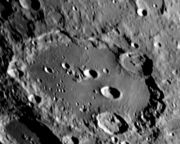
Clavius, the second largest crater on the visible hemisphere of the Moon (after Schickard), is circular and 231 Km
in diameter. Even for the Moon, this is an old crater, some 3,900 million years old. It is situated in the middle of the southern
highlands and is pock-marked with smaller craters within it. (It was featured by Arthur C. Clarke in his book "2001 A Space Odyssey"
in which Clavius was the site of the lunar base.)
This picture was taken with a ToUcam attached to my 254mm LX200 with a X2 adaptor lens on 1st March 2004, a night of exceptional seeing,
when the Moon was 9.7 days old. 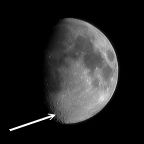
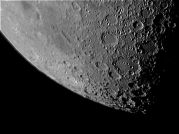
These pictures show much of the south-western quadrant of the Moon.
They taken with a ToUcam attached to my LX200 with a 0.33 focal reducer on 16th December 2003, when the Moon was 21.6 days old, and 12th November 2005, when the Moon was 11.5 days old.
The page also contains a picture of the area to the east of this one at a larger scale, taken at 18:25 UT on 15th July 2005, when the Moon was 8.5 days old.
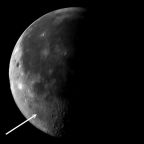
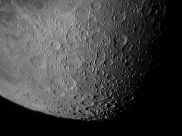
The south-polar area. The page contains three pictures, one wide-angle (as shown on the left) and two closer pictures of the south-pole area.
The picture was taken with a ToUcam attached to my LX200 with a 0.33 focal reducer when the Moon was 20.1 days old.
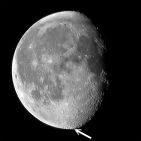
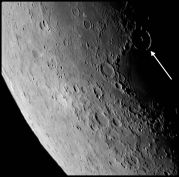
This picture is a composite of two pictures taken on the same night and shows the south-western limb of the Moon.
If you were there on the floor of the crater Gassendi the Sun would have set, but you would still be able
to see it striking the top of the central mountain and the mountains in the east.
The picture was taken with a ToUcam attached to my ETX125 on 23rd August 2003, when the Moon was 24.9 days old.
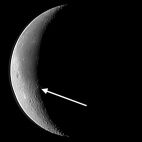
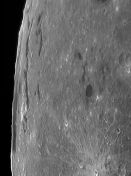
Pictures of Mare Orientale and its basin were taken at a time of particularly favourable libration for that area.
The pictures were taken with an Atik 1-HS attached to my LX200 and ETX125 on 24th to 29th June 2008, when the Moon was between 19.9 and 25.2 days old.
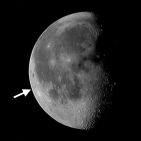
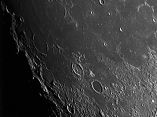
Hansteen and the area at the southern end of Oceanus Procellarum, 2½ days before Full Moon.

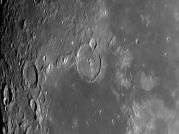
Gassendi is a large crater (114 Km in diameter) situated on the northern shores of the Mare Humorum. There are several central mountains, the highest being 1200 metres high. Other major craters in the picture are Mersenius and Cavendish.
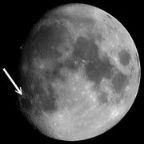
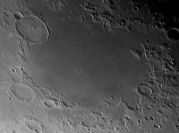
Mare Humorum is the most-clearly demarcated mare in the western hemisphere of the Moon. It is also one of the clearest impact basins anywhere on the Moon. The page includes a picture in exaggerated colours that may, or may not, show some things of interest.
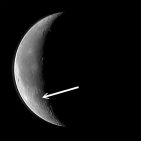
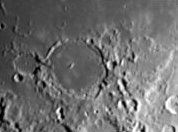
Pitatus is a battered crater on the southern shores of Mare Nubium. It is 34 Km in diameter
with rugged walls to the south. It has been flooded with lava from Mare Nubium in the north. It is connected
by a narrow valley to the neighbouring crater Hesiodus.
The picture was taken with my LX200 on 30th March 2003 at 21:10 UT when the Moon was 9.1 days old.
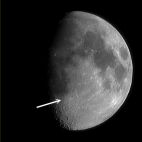
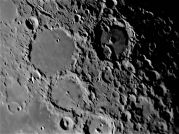
Ptolemaeus, Alphonsus and Albategnius to the east of Mare Nubium in the
southern hemisphere of the Moon.
The picture was taken with my LX200 on 17th October 2003 at 02:20 UT when the Moon was 20.8 days old.
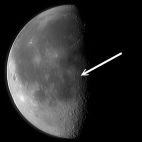
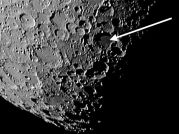
Stofler is 129 Km in diameter and 4,000 million years old and is surrounded by many other craters.
Faraday, to the south-east must be more recent, but dates from the same period. Over to the left
of this picture is Tycho, the centre of a brilliant ray system which shows up well at
full moon.
The picture was taken with my ETX125 on 21st June 2003 at 03:03 UT when the Moon was 21.6 days old.
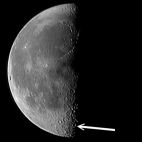
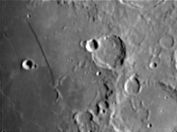
Thebit is a small (60 Km) but deep (3,270 m) crater with steep walls supporting Thebit A
to the north-west. Rupes Recta, also known as Huygen's Sword, is a fault 110 Km long
and between 240 and 300 metres high. It is not a cliff but a steep slope, being 2.5 Km wide.
The picture was taken with a ToUcam attached to my LX200 with X2 lens on 30th March 2004 at 2106 UT,
when the Moon was 9.1 days old.
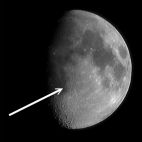
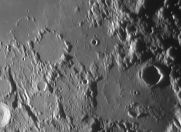
]
]
]
]
]
]
]
]
]
]
]
]
]
]
]
These six pictures cover a rugged area at the northern end of the southern highlands.
The four large craters, Ptolemaeus (158 Km in diameter), Albategnius (140 Km), Alphonsus (121 Km), and Arzachel (100 Km)
make an imposing quartet visible even on pictures of the whole Moon (see my picture
here). This is an area full of ancient craters more than 4,000 million years old, overlain
by a few more recent craters like Herschel and Horrocks which may be little more than 1,000 million years old.
In the top, left-hand corner of the image of Hipparchus is the Sinus Medii so called because it is in the very centre of the
visible face of the Moon; the prime meridian and the equator intersect within it.
Clicking on any one of these images will show you a larger version along with details of the features shown and
will give access to a mosaic of all six pictures.
The pictures were taken with a ToUcam attached to my LX200 with a X2 lens attached on 6th September 2004,
when the Moon was 21.8 days old.
]
]
]
]
]
]
]
]
]
]
]
]
]
]
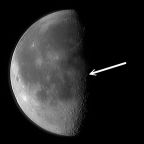
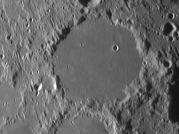
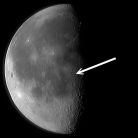
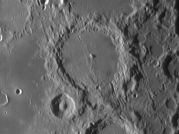
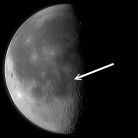
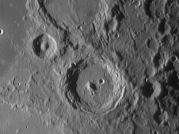
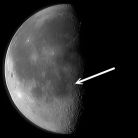
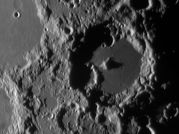
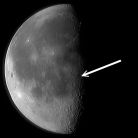
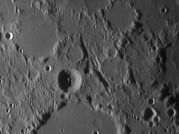
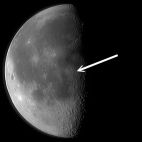
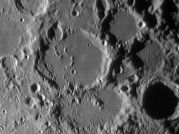
Purbach, Lacaille, and Blanchinus are ancient craters at about 4,200 million years, but at
least Purbach must be younger than Regiomontanus to its south. Werner is a much younger formation
between 1,100 and 3,200 million years. Although Thebit, at the top of this picture, is close to Arzachel,
I failed to include an overlapping region, so I cannot add it to my mosaic of this area.
The picture was taken with a ToUcam attached to my LX200 with a X2 adaptor lens on 6th September 2004
when the Moon was 21.8 days old.
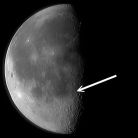
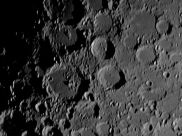
Walter is an old crater in the northern part of the southern highlands. It is elliptical,
measuring 145 by 136 Km and is around 3,900 million years old.
The picture was taken with a ToUcam attached to my LX200 on 19th December 2004 at 18:11 UT,
when the Moon was 8.4 days old.
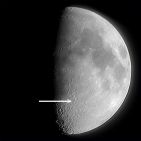
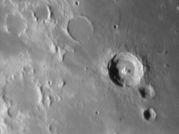
Bullialdus is an isolated circular formation on the western side of the Mare Nubium, with
a central mountain with multiple peaks. It is 63 Km in diameter and somewhere between 1,000 and 3,200 million years old. Its
sides are steep, tormented and 3500 metres high.
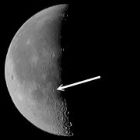
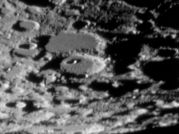
Casatus is 114 Km in diameter and 3900 metres deep. It forms a nice double with Klaproth,
122 km in diameter and 4300 metres deep. They are both about 4,000 million years old.
These formations are close to the south pole but the libration was particularly favourable at the time I took this picture.
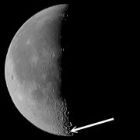
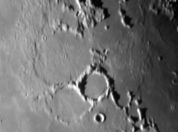
Fra Mauro, Parry and Bonpland make a pretty trio in this northern part
of the southern highlands. They are old and battered craters, some 4,000 million years old.
Apollo 14 landed just north of here.
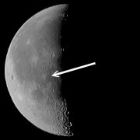
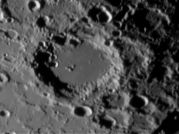
Longomontanus is a only about 300 Km north-west of Clavius, but somewhat smaller at 150 Km in diameter.
It is deep in the southern highlands and about 3,900 million years old.
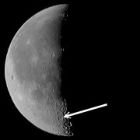
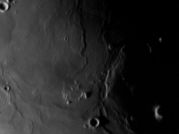
This is a part of the Mare Nubium imaged when the Sun was very low. This makes the
picture very dark but also brings out many ridges and wrinkles in the surface.
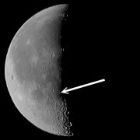
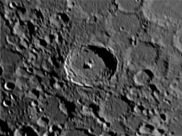
Tycho stands out so clearly at Full Moon, being the centre of the finest system of rays on the Moon. This
picture shows it at 12.2 days when much of the detail within and around the crater is visible. The page shows three
pictures at progressively greater magnifications, a fourth taken three days earlier and one taken at sunset, showing just how
rugged this part of the Moon is.
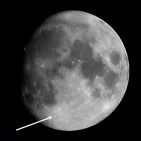
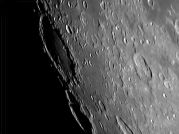
Schickard is the largest crater on the visible side of the Moon and is 233 Km in diameter.
It lies well over towards the western limb so appears highly elliptical even though it is in fact circular. Its
position makes it a difficult feature to image; this picture was taken only two days before full Moon.
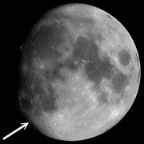
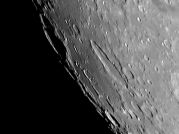
The most prominent feature here is Schiller, a genuinely elliptical crater 184 Km
long and 43 Km wide with a depth of 3900 metres. It may have been formed by the fusion of two
circular craters or possibly by a grazing impact. Either way, it was formed about 3,900 million
years ago. The floor is very flat to the south-east but much more tormented to the north-west.
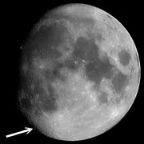
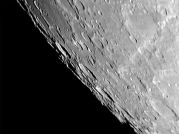
This area is just to the south of Schiller. The most recent feature is Zucchius,
less than about 1,000 million years old. It is 66 Km in diameter and 3300 metres deep.
Bettinus is 73 Km in diameter and also 3300 metres deep. Probably the oldest and deepest
crater here is Scheiner, 114 Km in diameter, 4000 metres deep, and 4,000 million years old.
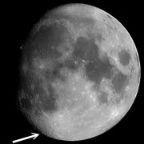
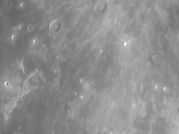
Mare Nubium is the site of the landing of both Surveyor 3 and Apollo 12. It
is situated south of Copernicus. The landing site of Apollo 12 is only about 180 Km west of the landing
site of Apollo 14 in the Fra Mauro highlands in the bottom right-hand corner of this picture. (See my
Apollo page.)
The picture was taken with a ToUcam attached to my LX200 when the Moon was 12.6 days old.
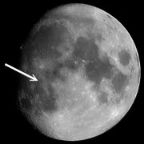
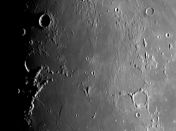
Another picture of the northern part of the Mare Nubium taken with earlier lighting than the image above.
This gives slightly longer shadows and accentuates some of the features.
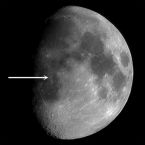
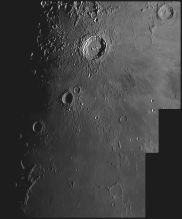
A mosaic of three pictures of the area south of Eratosthenes and Copernicus as far south
as Fra Mauro.
The picture was taken with a ToUcam attached to my LX200 when the Moon was 10.0 days old.
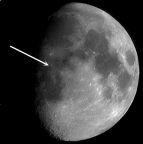
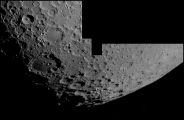
This mosaic of five images covers an area close to the south pole. It was taken when the libration was
particularly favourable for this area.
The pictures were taken with a ToUcam attached to my LX200 on 19th March 2005,
when the Moon was 9.1 days old.
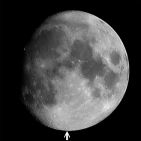
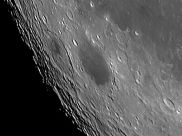
Grimaldi and Riccioli were 17th-century astronomers largely responsible
for the scheme we still use for naming features on the Moon. The craters they named
after themselves are the most prominent features in this picture.
The pictures were taken with a ToUcam attached to my LX200 on 24th March 2005,
when the Moon was 13.9 days old.
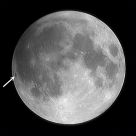
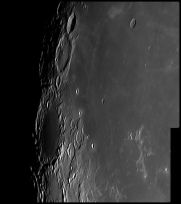
This picture is just to the north of the picture above and taken at about the same
lunation.
It was taken with a ToUcam attached to my LX200 when the Moon was 13.4 days old.
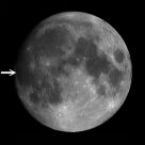
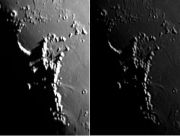
This is a picture of a lunar ray produced when the rising Sun shines through
a gap in the Riphaeus Mountains. An interesting phenomenon to observe although of little
other interest.
The pictures were taken with a ToUcam attached to my LX200 on 18th April 2005,
when the Moon was 9.5 days old.
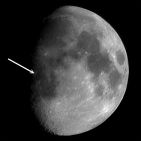
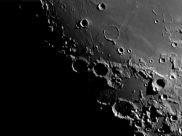
This is one picture from a sequence demonstrating sunrise on the Moon.
It contains a number of interesting features including a volcano.
The picture was taken with a ToUcam attached to my LX200 on 18th April 2005,
when the Moon was 9.5 days old.
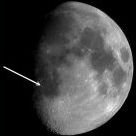
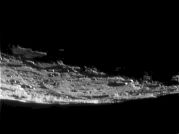
Clicking on this image will take you to a page showing eight pictures
taken on the same night when the Moon was 26.3 days old.
They were taken with a ToUcam attached to my LX200 on 31st August 2005 between 04:14 and 04:40 UT,
when the Moon was 26.3 days old.
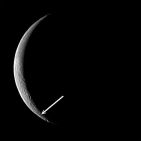
Home Back to the Moon